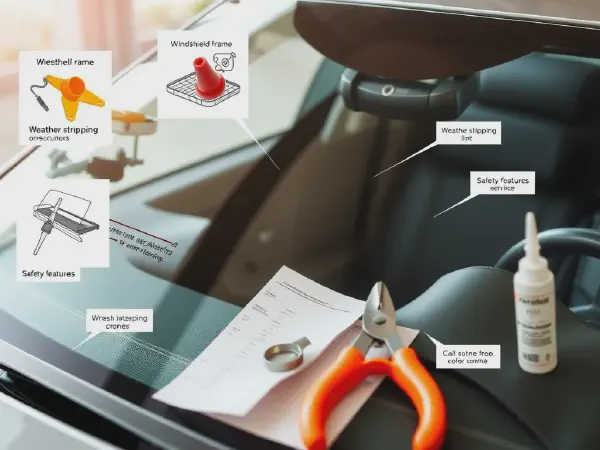Essential Guide to Windshield Replacement: What You Need

The Ultimate Guide to Windshield Replacement
Windshield Replacement is a crucial aspect of vehicle maintenance that ensures the safety of drivers and passengers. When a windshield gets damaged, it not only obstructs the view but can also compromise the structural integrity of the vehicle. Therefore, understanding the importance of timely windshield replacement can help drivers avoid greater risks on the road.
In many cases, small chips and cracks can lead to larger issues if not addressed. Windshield Replacement can be necessary when damage occurs beyond repair, and recognizing the types of damage that warrant a full replacement is vital. This guide aims to delve into the various aspects surrounding windshield replacement, ensuring you are well-informed when facing such a situation.
Modern windshields are not just a transparent barrier; they also play a significant role in vehicle safety features, including airbags and advanced driver-assistance systems (ADAS). Therefore, choosing the right windshield replacement is essential for maintaining the functionality of these systems, making it ever more important to understand what goes into the replacement process and the types available.
When it comes to getting a windshield replaced, car owners have several options. They can opt for OEM (Original Equipment Manufacturer) windshields or aftermarket products. Additionally, understanding the different types of glass—laminated vs. tempered—sectioning through repair vs. total replacement, and the modern features incorporated in windshields today can make your decision more informed and tailored to your vehicle's needs.
Overall, this article will provide an in-depth look at the windshield replacement process, including the various factors that contribute to costs, safety considerations after replacement, and the benefits of professional replacement versus DIY methods. By the end, you'll know all you'll need to about making an educated decision regarding windshield replacement.
Types of Windshield Replacement
There are primarily two types of windshields available for replacement – OEM and aftermarket. OEM windshields are made by the same manufacturer as the original part, ensuring a perfect fit and adherence to safety standards. Aftermarket windshields, on the other hand, are produced by third-party companies and may offer less rigid adherence to such standards but often come at a lower cost.
In addition, windshields can be categorized based on the type of glass used. Laminated glass consists of two layers of glass with an interlayer of polyvinyl butyral (PVB) that holds the glass together when shattered. Tempered glass is made by heating it to high temperatures and cooling it rapidly, making it more shatter-resistant. Understanding the differences between these two will help you choose the most suitable option for your vehicle.
Furthermore, it’s essential to distinguish between when to opt for a full windshield replacement versus a repair. Small chips and minor cracks can sometimes be repaired without the need for full replacement. Still, if the damage is extensive, in the driver’s line of sight, or compromising the structural integrity, a full replacement is often necessary.
For reliable windshield repair and replacement services, turn to Faith Autoglass for exceptional quality and customer care.
Modern windshields are equipped with features that enhance safety, such as acoustic insulation for noise reduction and embedded sensors for advanced driver-assistance systems. Being aware of these unique features helps you select a windshield that maintains the functionality of these systems after replacement.
Windshield Replacement Process
The windshield replacement process can be broken down into several steps. Firstly, the area around the windshield is prepared, often removing any trim or moldings to gain access. Then the old windshield is carefully removed, and the frame is cleaned to ensure proper adhesion for the new windshield. The new glass is then installed using a suitable adhesive, and trim pieces are reattached as necessary.
Before the new windshield is installed, a thorough inspection of the vehicle is conducted. This involves assessing the damage and determining the correct type of windshield needed for replacement. It’s important to check if the windshield frame is free of rust or significant damage to ensure a secure fit for the new windshield.
For the replacement itself, specific tools and materials are required, such as a windshield removal blade, sealant, appropriate adhesives, and suction cups for safe handling of the glass. Having the right tools ensures the job is done correctly and reduces the risk of issues arising from improper installation.
After the replacement, it's vital to follow post-replacement care tips such as waiting for a specific period before driving to allow the adhesive to cure fully. Keeping the vehicle out of heavy rain and avoiding car washes for a short time after replacement are also recommended to ensure the seal remains intact.
Cost Factors in Windshield Replacement
The average cost of windshield replacement varies significantly based on several factors, including the make and model of the vehicle. Generally, prices can range from $200 for standard cars to over $1,000 for luxury vehicles or those with advanced safety features.
Insurance can significantly influence replacement costs. Many insurance policies include coverage for windshield damage, which can dramatically reduce out-of-pocket expenses. Understanding your policy’s coverage can help inform your decisions when getting your windshield replaced.
However, hidden fees can sometimes add to total costs, including charges for disposal of the old windshield, service fees, and potential add-ons like advanced driver-assistance system calibration. It’s advisable to inquire about all possible costs up front to avoid any surprises.
Additionally, the location of the service center can impact costs, as labor rates differ from one geographic area to another, along with availability of specific types of windshields. Some areas with more specialized services might charge a premium for expedited replacements.
Safety Considerations After Replacement
Professional installation is critical after a windshield replacement. A certified technician ensures that the proper adhesives are used and that the replacement meets safety standards. Handling the installation process yourself may lead to issues that could compromise safety on the road.
To check for seal integrity after installation, inspect the edges of the windshield for any visible gaps or irregularities. Ensure that the molding is fitted correctly, and look for signs that the glass has been adequately secured.
Be alert for any signs of poor installation, such as wind noise while driving, water leaks around the edges, or if the glass appears to be shifting in place. These issues indicate that the windshield may not have been correctly installed and require immediate attention.
Finally, it’s crucial to understand the legal requirements regarding windshield standards in your area. Many regions have specific regulations concerning the types of windshields that can be installed and standards they must meet to ensure vehicle safety. Compliance with these standards protects you legally and ensures safety on the road.
DIY vs Professional Windshield Replacement
When considering replacement options, weighing the pros and cons of DIY versus professional windshield replacement is essential. DIY replacement allows for cost savings and flexibility in scheduling; however, it carries the risk of improper installation and potential safety issues.
Cost-wise, while a DIY replacement kit may only cost $50 to $150, professional services generally range from $200 to $1,500, influenced by vehicle specifics and location. Ultimately, the initial savings of DIY work may not outweigh potential repair costs needed for a poorly installed windshield.
For a DIY replacement, you will need tools such as a windshield removal kit, adhesive, and safety gear. Understanding the proper procedures for installation is crucial to mitigate risks associated with replacing the windshield without professional assistance.
However, there are specific circumstances where calling a professional is the best course of action. If you are unsure about the damage extent, lack the necessary tools, or if your vehicle has advanced safety features that require calibration, seeking a professional ensures the job is done right the first time.
